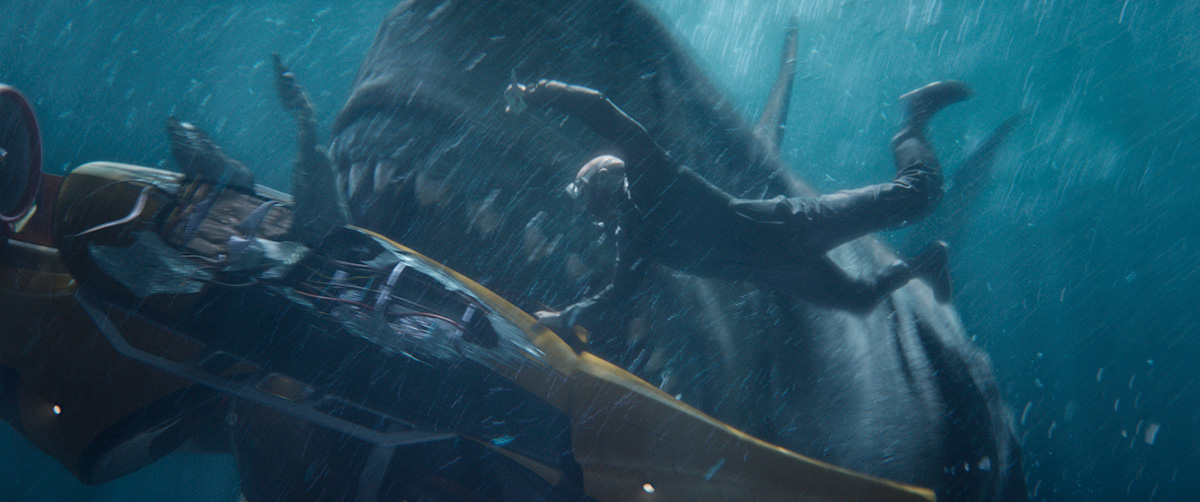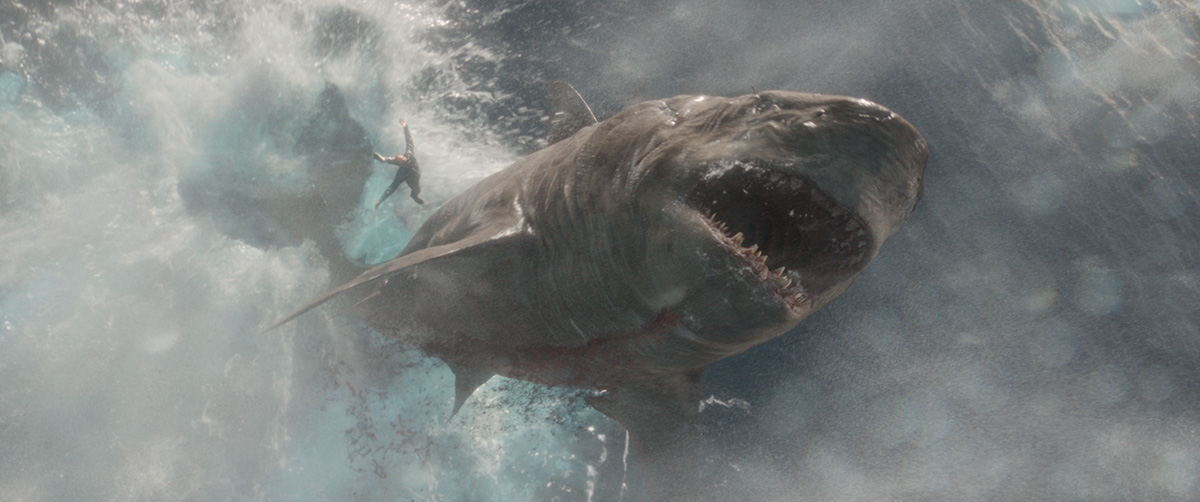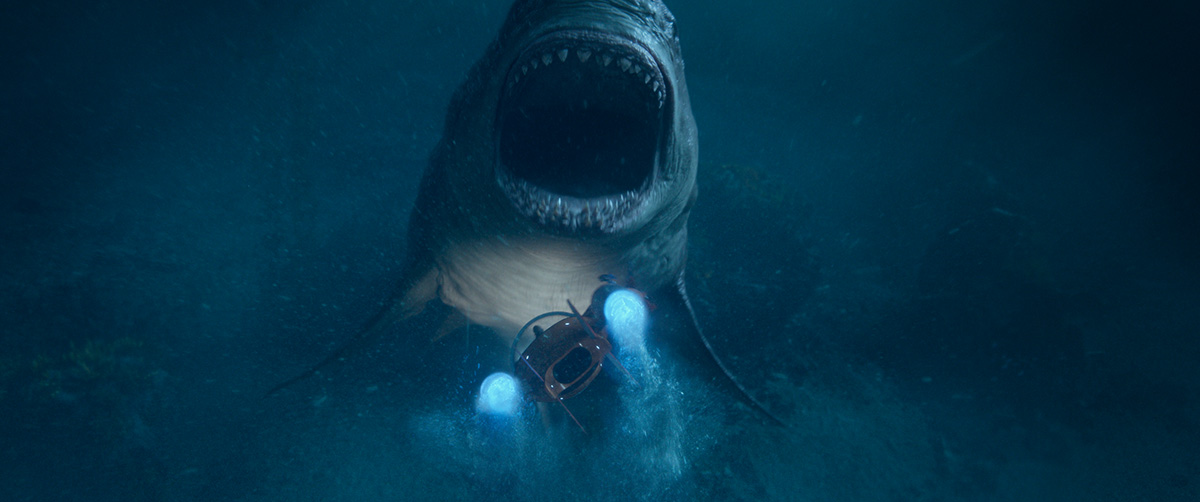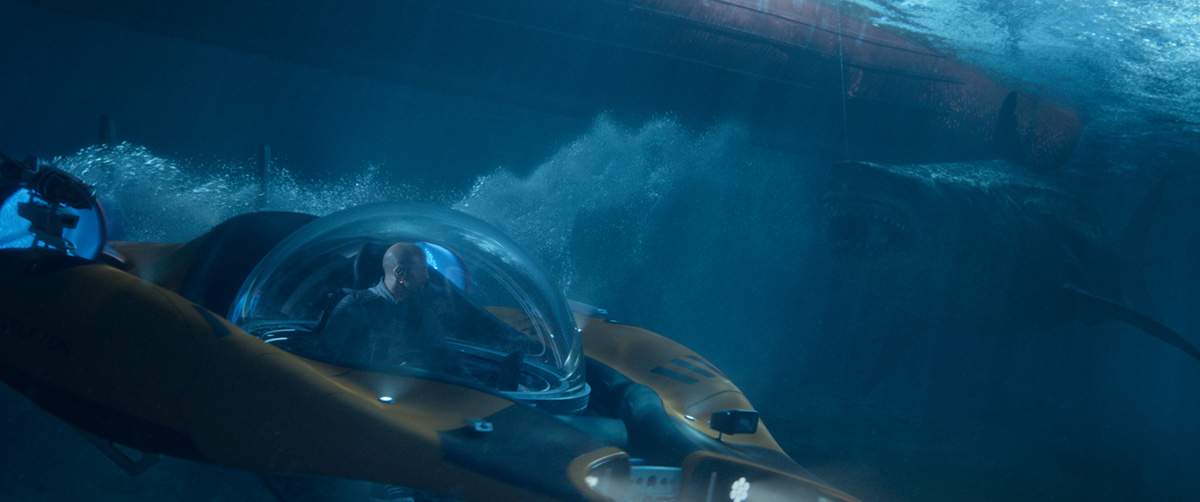The Meg: How Imageworks Weaved a Wealth of Water Effects
Jon Turteltaub’s The Meg features giant sharks, large-scale ocean action scenes and some pretty nifty submarine gliders. So much of the film required water interaction - both on top and underneath the surface - that visual effects were a key component in getting The Meg done. Helping to craft these VFX was Sony Pictures Imageworks, which utilised Houdini in a big way to deal with all the different kinds of water simulations in the movie.
Houdini’s Reach
The giant shark, or megalodon, is seen several times in the film making large crashing impacts on the water surface, generating spray and wakes in the ocean surface, and distorting underwater volumes as it powers through the water. Imageworks relied on Houdini not only for those big moments, but also for the rivulets on the creature’s skin, droplets on its teeth and for what were called ‘streamers’ coming from the Meg’s gills and mouth.

“In addition to the effect the Meg had on the water,” says Imageworks CG supervisor Joseph Pepper, “we also simulated the large body of ocean water itself, seen from both above and below. From under the water looking up at the surface we simulated foam, whitecaps, aeration near areas of churn and break on the surface, bubbles, and misty particulate.”
But the use of Houdini did not end there. Other underwater effects were also achieved with the software. This included torpedo slip streams, underwater explosions, bubbles from breathing apparatus, oil slicks, ripping up of the submarine gliders, smashing glass, blood, sharks eating Meg flesh, coral/rock destruction, silt kicked up from the ocean floor and simulated schools of underwater fish. Above the water, Houdini came into use for depth charge explosions, smoke and a helicopter crash.
In addition to the effect the Meg had on the water, we also simulated the large body of ocean water itself, seen from both above and below. From under the water looking up at the surface we simulated foam, whitecaps, aeration near areas of churn and break on the surface, bubbles, and misty particulate.
Joseph Pepper – CG supervisor, Sony Pictures ImageworksThen there were the underwater environments, specifically underwater vegetation for scenes set in and around Sanja Bay in the film. “While Imageworks used its in-house tool Sprout to populate and drive composition of the underwater rocks and vegetation,” notes Pepper, “Houdini's finite element solver was used to bring the underwater plants to life in various forms of kelp which swayed in underwater currents and reacted to the Meg to help sell the scale of the creature.”
Water, Water Everywhere
Houdini’s FLIP and whitewater solvers were used to deal with surface water and water interaction, although Imageworks customised the solvers to deal with scale on a shot-per-shot basis. Pepper explains: “To get a sense of air resistance and ‘vaporizing’ you tend to see in large scale water, we realised we needed a hybrid flip and gas solution to achieve the look. Essentially, for large scale impacts, water quickly starts to behave almost like a gas as the force causes particles to behave without surface tension. The hard part was seamlessly combining that with bodies of water where that cohesion was still present.

The Meg breaches the water in one of the biggest Imageworks shots in the film.
“A common reference point we went back to for scale was iceberg collapses - one of the few events on earth where a mass of water that size is disturbed - of which there are plenty of reference videos. Our custom approach involved a feedback between Pyro and FLIP simulations, merging into driving the whitewater solver which meant we could insert divergence and other characteristics into the water sims and achieve the air resistance that shows the swirls and eddies you associate with very large events like iceberg collapses.”
In particular, Imageworks delivered a climactic Meg breach towards the end of the film. Those shots were led by Viktor Lundqvist, who used the custom approach referred to above. Alvin Yap, Oleksandr Loboda and Toby Rosen also added multiple additional layers, overseen by Imageworks visual effects supervisor Sue Rowe.
Above the surface, adds Pepper, “we used a combination of FLIP, a custom ripple solver, procedural displacement and the Houdini ocean tools to do things like glider wakes when they're above water, wakes from the evac ship and splashes and wakes from the Meg swimming.”
Into the Shallows
Imageworks’ underwater shots were mostly of the shallows environment of Sanja Bay. The challenge here was to realize scenes that would show vast underwater surfaces and allow audiences to see enough of the action. Too much ‘clear’ water appeared uninteresting, but too much water filled with particulate would hamper the view.

The Meg attacks Jonas in the shallows.
“The FX team helped address this balance in a couple of significant ways,” says Pepper. “First, DFX supervisor Jason Greenblum had done tests very early on in production with particulate ‘motes’ flying by camera, and from those early tests and the reference footage he found it quickly became obvious that this would be a simple yet crucial element to sell the immersion of feeling underwater. Every underwater shot Imageworks did in The Meg had millions of motes simulated and rendered. These along with other auxiliary elements helped the comp teams add a feeling of depth and occlusion to the underwater shots without completely obscuring the action we needed to focus on. It also helped give lighting cues as refracted light from the ocean surface would glint and illuminate from these elements and helped the comp team distort and muddy the ocean in creative ways that balanced these competing needs.
For the ocean itself, once we realized our initial tests looked too uniform in larger areas, our compositing supervisor, Pablo Holcer, suggested adding areas of aeration and churn under the surface of the ocean. To achieve this, we simulated underwater bubbles from areas of high vorticity on the ocean surface and used those to drive high buoyancy gas simulations for the churned look under the surface.
“Second, for the ocean itself, once we realised our initial tests looked too uniform in larger areas, our compositing supervisor, Pablo Holcer, suggested adding areas of aeration and churn under the surface of the ocean. To achieve this, we simulated underwater bubbles from areas of high vorticity on the ocean surface and used those to drive high buoyancy gas simulations for the churned look under the surface. We found great reference people had shot underneath breaking waves on a beach. Of course, most of our environment didn't have these large breaking waves but the visual clues were enough to help us make our larger ocean surfaces more interesting and varied when seen from underneath over larger expanses.”
One crucial component to this work was the addition by Imageworks artists of a custom ‘micro ripple’ solver. It triggered millions of tiny ripples on the ocean surface from where droplets were either landing from above or bubbles hitting the surface from below. Due to the acute detail of these tiny events the setup was primarily used to drive shaders in Arnold to add this feature at render time. “The great strength of Houdini in this process was that by the time of heavy shot production the ocean FX could be run automatically either from a command line or from animation updates, freeing up artists to focus on more unique shot tasks,” notes Pepper.
Finally, for the shots where the Meg is close to the ocean floor, Jacob Clarke, Stephanie Molk and Dmitriy Kolesnik simulated silt being kicked up and pushed around by the Meg, “crucial,” says Pepper, “in selling the idea of this gigantic leviathan disturbing its new environment.”
Let’s Learn About Cavitation
The underwater gliders push through the water and emit streams of bubbles, known as cavitation, where the water is actually boiling from the motion of the propellers. At Imageworks, Theo Vandernoot used Houdini to automate a system that generated cavitation made of multiple layers of bubbles and particulate each time animation on the underwater gliders was updated. To get to that stage, however, the studio first looked to reference, as Pepper describes.

Realistic cavitation for the bubbles emanating from the submarine gliders was a large part of Imageworks’ underwater effects.
“Very early on we had great close up reference footage of spinning propeller blades from an anchored boat. The blades would start from a standstill then slowly start to spin, moving faster and faster. You could see this progression from tiny bubbles coming off the barely moving blades, gradually bringing more and more ‘stuff’ from the ocean into the orbit of the blades until it eventually ended in a swirling mass of silt, particulate and bubbles.
“We started off by mocking up our own spinning blades and injecting heat, divergence and density from the blade tips into a Pyro sim. To give more control we added a scalable vortex cylinder behind the blades so we could more easily drive the speed and size of the mass of cavitation the propellers left behind. This base Pyro sim was then used to advect particles which mostly represented bubbles. We also gave the bubbles their own buoyancy and turbulence control so we could have them move up and out faster or slower depending on the shot. From this basic approach, Theo built an automated system to get initial cavitation passes in Houdini directly from animation without any user input.”
That setup was later customized to deal with notes from the director. The cavitation was effectively art-directed, sometimes to avoid the bubbles covering up the face of the Meg or the actors, or getting in the way of the action. FX lead David Allen customised the existing cavitation setup to give greater control and cheat certain shots to help the continuity and action. This particularly came into play during a sequence that became known as ‘the showdown at Ok Corral’, where the main character Jonas faces off with the Meg and ends up spun upside down in his glider.
“Rather than any single shot, this set of shots together required lots of customized control for both continuity and composition,” outlines Pepper. “First, we had very wide long shots of the glider creating cavitation that could be seen rising and forming a long trail. Given that there was no real life equivalent of this that you could see very easily, we had to balance the feel of a long trail, with rising bubbles, without distracting from the main focus of the shot - the faceoff between the Meg and Jonas in the glider. This took a lot of iterations to get the balance between something realistic and something not distracting.”
“Second,” adds Pepper, “the following shots in this part of the sequence see the glider and the Meg in close contact, racing across each other, and eventually culminate in the glider being flipped upside down. Much of this is seen from the viewpoint of the glider. This amount of chaos became almost impossible to achieve with our default cavitation setup, so we ended up duplicating the process from multiple, invisible propeller blades placed off camera to fake all the extra cavitation needed to fill the screen space behind Jonas and covey the required disorientation.”
Delivering Meg-Sized Effects
Imageworks renders for The Meg were mostly carried out in Arnold, but the studio also used a fair amount of custom data exported from Houdini to drive aspects of the shading. Lookdev lead Craig Feifarek was partially embedded into the FX team in order to smooth this process. The Imageworks FX team itself comprised over 30 FX artists across the show, with multiple leads and two production coordinators - Stef Muyco and David Cohan.
“I think anyone who sees the movie will immediately appreciate the scale and difficulty of the work undertaken,” says Pepper. “There was almost every conceivable type of effect executed by the team. Perhaps what is less apparent is the work of the production team at Imageworks coordinating all the changes and updates in a movie of this kind. It's the only way this breadth of work can even be attempted in the first place.”
COMMENTS
Rezo233 6 years, 4 months ago |
I guess this movie was really hard to make. Houdini is the real best!!!!
Please log in to leave a comment.